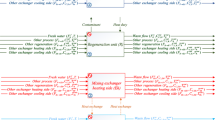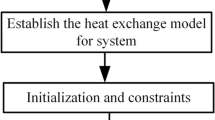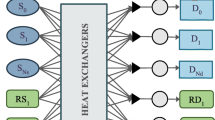Abstract
In this paper, a novel approach for the synthesis of water network incorporated with process models is introduced. The process models are utilized to relate the variables (i.e., flow rate and concentration) of process output (typically defined as internal water source) with those of process input (i.e., water sink). A generalized water network superstructure is developed to embed all possible process units and all the connections among resources, interceptors, process units, and wastes. The problem is formulated as four optimization problems (minimum freshwater flow rate, intercepted flow rate, intercepted mass load, and number of connections), and the four models are solved in sequence to locate the targets. A literature case is used to validate the proposed approach. Moreover, a sour water network of a practical refinery plant is presented to illustrate the applicability and effectiveness of the proposed approach.






Similar content being viewed by others

Abbreviations
- NFS:
-
Set of fresh sources
- NPU:
-
Set of process units
- NIU:
-
Set of interceptor units
- NCOMP:
-
Set of components
- s :
-
Index for fresh source
- u :
-
Index for process unit
- i :
-
Index for interceptor unit
- c :
-
Index for component
- λ :
-
Slack factor
- xFS s,c :
-
Concentration of component c in fresh source s (ppm)
- xFU in,max u,c :
-
Maximum inlet concentration of component c for process unit u (ppm)
- xFU out,max u,c :
-
Maximum outlet concentration of component c for process unit u (ppm)
- RR i,c :
-
Removal ratio for component c for interceptor unit i
- xFI in,LB i,c :
-
Lower bound for inlet concentration of component c for interceptor unit i (ppm)
- xFI in,UB i,c :
-
Upper bound for inlet concentration of component c for interceptor unit i (ppm)
- xFE UB c :
-
Upper bound for the concentration of component c for environment (ppm)
- FSmin :
-
Minimum flow rate for the freshwater sources (t/h)
- FImin :
-
Minimum flow rate for the interception units (t/h)
- MFImin :
-
Minimum interception mass load for the interceptors (kg/h)
- ΔFU u :
-
Delta flow rate for process unit u (t/h)
- FS s :
-
Flow rate allocated from freshwater source s (t/h)
- FSU s,u :
-
Flow rate from freshwater source s to process unit u (t/h)
- FSI s,i :
-
Flow rate from freshwater source s to interceptor unit i (t/h)
- FU in u :
-
Inlet flow rate for process unit u (t/h)
- FU out u :
-
Outlet flow rate for process unit u (t/h)
- FUU u′,u :
-
Flow rate from process unit u′ to process unit u (t/h)
- FUI u,i :
-
Flow rate from process unit u to interceptor unit i (t/h)
- FUE u :
-
Flow rate from process unit u to environment (t/h)
- FIU i,u :
-
Flow rate from interceptor unit i to process unit u (t/h)
- FI in i :
-
Inlet flow rate for interceptor unit i (t/h)
- FII i′,i :
-
Flow rate from interceptor unit i′ to interceptor unit i (t/h)
- FIE i :
-
Flow rate from interceptor unit i to environment (t/h)
- xFU in u,c :
-
Inlet concentration of component c for process unit u (ppm)
- xFU out u′,c :
-
Outlet concentration of component c for process unit u (ppm)
- xFI in i,c :
-
Inlet concentration of component c for interceptor unit i (ppm)
- xFI out i,c :
-
Outlet concentration of component c for interceptor unit i (ppm)
- ΔM u,c :
-
Mass load of component c for process unit u (kg/h)
- FE:
-
Total flow rate discharged to the environment (t/h)
- xFE c :
-
Concentration of component c discharged to the environment (ppm)
- yFSU s,u :
-
Connection variable from freshwater source s to process unit u
- yFSI s,i :
-
Connection variable from freshwater source s to interceptor unit i
- yFUU u′,u :
-
Connection variable from process unit u′ to process unit u
- yFUI u,i :
-
Connection variable from process unit u to interceptor unit i
- yFIU i,u :
-
Connection variable from interceptor unit i to process unit u
- yFII i′,i :
-
Connection variable from process unit i′ to interceptor unit i
- yFIE i :
-
Connection variable from interceptor unit i to environment
- LB:
-
Lower bound
- UB:
-
Upper bound
- Lim:
-
Limiting value
- min:
-
Minimum
- max:
-
Maximum
- in:
-
Inlet
- out:
-
Outlet
- max_input:
-
Maximum input
- max_output:
-
Maximum output
References
Agrawal V, Shenoy UV (2006) Unified conceptual approach to targeting and design of water and hydrogen networks. AIChE J 52(3):1071–1082
Ahmetović E, Grossmann IE (2011) Global superstructure optimization for the design of integrated process water networks. AIChE J 57(2):434–457
Alva-Argáez A, Kokossis AC, Smith R (2007) The design of water-using systems in petroleum refining using a water-pinch decomposition. Chem Eng J 128(1):33–46
Alwi SRW, Manan ZA (2006) SHARPS: a new cost-screening technique to attain gost-effective minimum water network. AIChE J 52(11):3981–3988
Bagajewicz M (2000) A review of recent design procedures for water networks in refineries and process plants. Comput Chem Eng 24(9–10):2093–2113
Bagajewicz M, Savelski M (2001) On the use of linear models for the design of water utilization systems in process plants with a single contaminant. Chem Eng Res Des 79(A5):600–610
Bai J, Feng X, Deng C (2007) Graphically based optimization of single-contaminant regeneration reuse water systems. Chem Eng Res Des 85(A8):1178–1187
Bai J, Feng X, Deng C (2010) Optimal design of single-contaminant regeneration reuse water networks with process decomposition. AIChE J 56(4):915–929
Bandyopadhyay S, Cormos CC (2008) Water management in process industries incorporating regeneration and recycle through a single treatment unit. Ind Eng Chem Res 47(4):1111–1119
Bandyopadhyay S, Ghanekar MD, Pillai HK (2006) Process water management. Ind Eng Chem Res 45(15):5287–5297
Castro P, Matos H, Fernandes MC, Nunes CP (1999) Improvements for mass-exchange networks design. Chem Eng Sci 54(11):1649–1665
Chan JH, Foo DCY, Kumaresan S, Aziz RA, Abu-Hassan MA (2008) An integrated approach for water minimisation in a PVC manufacturing process. Clean Technol Environ Policy 10(1):67–79
Chen C-L, Lee J-Y, Ng DKS, Foo DCY (2010) Synthesis of resource conservation network with sink–source interaction. Clean Technol Environ Policy 12(6):613–625
Deng C, Feng X (2011) Targeting for conventional and property-based water network with multiple resources. Ind Eng Chem Res 50(7):3722–3737
Deng C, Feng X, Bai J (2008) Graphically based analysis of water system with zero liquid discharge. Chem Eng Res Des 86(A2):165–171
Deng C, Feng X, Ng DKS, Foo DCY (2011) Process-based graphical approach for simultaneous targeting and design of water network. AIChE J 57(11):3085–3104
Dhole VR, Ramchandani N, Tainsh RA, Wasilewski M (1996) Make your process water pay for itself. Chem Eng 103(1):100–103
El-Halwagi MM, Gabriel F, Harell D (2003) Rigorous graphical targeting for resource conservation via material recycle/reuse networks. Ind Eng Chem Res 42(19):4319–4328
Faria DC, Bagajewicz MJ (2010) On the appropriate modeling of process plant water systems. AIChE J 56(3):668–689
Feng X, Bai J, Zheng XS (2007) On the use of graphical method to determine the targets of single-contaminant regeneration recycling water systems. Chem Eng Sci 62(8):2127–2138
Feng X, Bai J, Wang HM, Zheng XS (2008) Grass-roots design of regeneration recycling water networks. Comput Chem Eng 32(8):1892–1907
Foo DCY (2009) State-of-the-art review of pinch analysis techniques for water network synthesis. Ind Eng Chem Res 48(11):5125–5159
Foo DCY (2012) Process integration for resource conservation. CRC Press, Boca Raton
Foo DCY (2013) A generalised guideline for process changes for resource conservation networks. Clean Technol Environ Policy 15(1):45–53
Foo DCY, Manan ZA, El-Halwagi MM (2006a) Correct identification of limiting water data for water network synthesis. Clean Technol Environ Policy 8(2):96–104
Foo DCY, Manan ZA, Tan YL (2006b) Use cascade analysis to optimize water networks. Chem Eng Prog 102(7):45–52
Gunaratnam M, Alva-Argáez A, Kokossis A, Kim JK, Smith R (2005) Automated design of total water systems. Ind Eng Chem Res 44(3):588–599
Hallale N (2002) A new graphical targeting method for water minimisation. Adv Environ Res 6(3):377–390
Handani ZB, Wan Alwi SR, Hashim H, Manan ZA (2010) Holistic approach for design of minimum water networks using the mixed integer linear programming (MILP) technique. Ind Eng Chem Res 49(12):5742–5751
Handani ZB, Wan Alwi SR, Hashim H, Manan ZA, Sayid Abdullah SHY (2011) Optimal design of water networks involving multiple contaminants for global water operations. Asia-Pac J Chem Eng 6(5):771–777
Hu N, Feng X, Deng C (2011) Optimal design of multiple-contaminant regeneration reuse water networks with process decomposition. Chem Eng J 173(1):80–91
Huang CH, Chang CT, Ling HC, Chang CC (1999) A mathematical programming model for water usage and treatment network design. Ind Eng Chem Res 38(7):2666–2679
Jezowski J (2010) Review of water network design methods with literature annotations. Ind Eng Chem Res 49(10):4475–4516
Karuppiah R, Grossmann IE (2006) Global optimization for the synthesis of integrated water systems in chemical processes. Comput Chem Eng 30(4):650–673
Khor CS, Chachuat B, Shah N (2012) A superstructure optimization approach for water network synthesis with membrane separation-based regenerators. Comput Chem Eng 42:48–63
Kim J-K (2012) System analysis of total water systems for water minimization. Chem Eng J 193–194:304–317
Klemeš JJ (2012) Industrial water recycle/reuse. Curr Opin Chem Eng 1(3):238–245
Liu Y, Feng X, Chu KH, Deng C (2012) Optimization of water network with single and two outflow water-using processes. Chem Eng J 192:49–57
Manan ZA, Tan YL, Foo DCY (2004) Targeting the minimum water flow rate using water cascade analysis technique. AIChE J 50(12):3169–3183
Mann JG, Liu YA (1999) Industrial water reuse and wastewater minimization. McGraw-Hill Professional, New York
Meyer CA, Floudas CA (2006) Global optimization of a combinatorially complex generalized pooling problem. AIChE J 52(3):1027–1037
Misener R, Floudas CA (2010) Global optimization of large-scale generalized pooling problems: quadratically constrained MINLP models. Ind Eng Chem Res 49(11):5424–5438
Ng DKS, Foo DCY, Tan RR (2009a) Automated targeting technique for single-impurity resource conservation networks. Part 1: direct reuse/recycle. Ind Eng Chem Res 48(16):7637–7646
Ng DKS, Foo DCY, Tan RR (2009b) Automated targeting technique for single-impurity resource conservation networks. Part 2: single-pass and partitioning waste-interception systems. Ind Eng Chem Res 48(16):7647–7661
Polley GT, Polley HL (2000) Design better water networks. Chem Eng Prog 96(2):47–52
Ponce-Ortega JM, Hortua AC, El-Halwagi M, Jimenez-Gutierrez A (2009) A property-based optimization of direct recycle networks and wastewater treatment processes. AIChE J 55(9):2329–2344
Ponce-Ortega JM, Mosqueda-Jiménez FW, Serna-González M, Jiménez-Gutiérrez A, El-Halwagi MM (2011) A property-based approach to the synthesis of material conservation networks with economic and environmental objectives. AIChE J 57(9):2369–2387
Ponce-Ortega J, Nápoles-Rivera F, El-Halwagi M, Jiménez-Gutiérrez A (2012) An optimization approach for the synthesis of recycle and reuse water integration networks. Clean Technol Environ Policy 14(1):133–151
Prakash R, Shenoy UV (2005) Targeting and design of water networks for fixed flowrate and fixed contaminant load operations. Chem Eng Sci 60(1):255–268
Smith R (2005) Chemical process design and integration, 2nd edn. Wiley, Chichester
Takama N, Kuriyama T, Shiroko K, Umeda T (1980) Optimal water allocation in a petroleum refinery. Comput Chem Eng 4(4):251–258
Tan YL, Manan ZA (2006) Retrofit of water network with optimization of existing regeneration units. Ind Eng Chem Res 45(22):7592–7602
Wagialla KM, El-Halwagi MM, Ponce-Ortega J (2012) An integrated approach to the optimization of in-plant wastewater interception with mass and property constraints. Clean Technol Environ Policy 14(2):257–265
Wang YP, Smith R (1994) Wastewater minimisation. Chem Eng Sci 49(7):981–1006
Wang YP, Smith R (1995) Wastewater minimization with flowrate constraints. Chem Eng Res Des 73(A8):889–904
Zheng PY, Feng X, Qian F, Cao DL (2006) Water system integration of a chemical plant. Energy Convers Manage 47(15–16):2470–2478
Acknowledgments
Financial support provided by the National Basic Research Program of China (No. 2012CB720500) and the National Natural Science Foundation of China united with China National Petroleum Corporation (No. U1162121) are gratefully acknowledged. The research is also supported by Science Foundation of China University of Petroleum, Beijing (No. YJRC-2011-08 and LLYJ-2011-61).
Author information
Authors and Affiliations
Corresponding author
Appendix
Appendix
As mentioned in the proposed NLP/MINLP optimization model, the appropriate determination of lower and upper bounds for those variables is necessity for process operation. Besides, the given appropriate bounds would narrow the solving space and are helpful for the solving procedure.
For each process unit, the inlet flow rate cannot exceed its maximum input capacity. Hence, the upper bounds (FSU UB s,u and FUU UB u′,u ) would be set to equal to the maximum input capacity (FU max_input u ).
Besides, the outlet flow rate for each process unit cannot exceed its maximum output capacity. Thus, the upper bounds (FUU UB u,u′ and FUE UB u ) would be set to equal to the maximum output capacity (FU max_output u ).
Similarly, the inlet/outlet flow rate for each interceptor unit cannot exceed its maximum input/output capacity. Thus, the upper bounds (FSI UB s,i , FII UB i′,i , FII UB i,i′ and FIE UB i ) could be set to equal to the maximum input/output capacity.
In addition, the upper bounds (FUI UB u,i and FIU UB i,u ) would be restricted by the minimum input/output capacities for both process unit and interceptor unit. Thus, the upper bounds (FUI UB u,i and FIU UB i,u ) could be determined by the following equations:
Rights and permissions
About this article
Cite this article
Deng, C., Feng, X. & Wen, Z. Optimization of water network integrated with process models. Clean Techn Environ Policy 15, 473–487 (2013). https://doi.org/10.1007/s10098-013-0609-3
Received:
Accepted:
Published:
Issue Date:
DOI: https://doi.org/10.1007/s10098-013-0609-3



